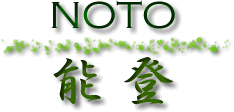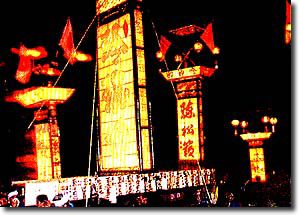|
| TRIP OUT TOP | |
|
If you don't make it to the famed Tohoku festivals at the beginning of this month, one other area still boasts quite a few festivals. The Noto Peninsula versions feature 9-meter tall lanterns (some smaller ones, at 4 meters, are for children) called kiriko. Other dialects call them hootoo or o-akashi. More often these days, because of electrification, the smaller kiriko are used.
Some 800 kiriko are used in festivals all over the peninsula. As with the festivals up in Tohoku, it's not easy to catch them all in the shortest possible time -- i.e. the cheapest possible way. But take it easy, have a swim in the ocean and enjoy some unspoiled scenery along the way. Togi-machi features Noto Kiriko: Hassaku Matsuri, which takes place on August 13 and 14, and is one of the so-called kisai, or "exotic" festivals which in the olden days was held on August 1. Near Togi is a 30-kilometer long scenic coastline which has wonders such as Ganmon, a grotto 6 meters wide, 15 meters tall and 60 meters deep, created by erosion. On top is a thick growth of old pines. Other famous rock formations include the Taka no Su (Hawk's Nest) at 27 meters, Kabuto Iwa, a rock in the shape of an old military helmet, Senjojiki Iwa, and Yase no Dangai cliff, which was used as Matsumoto Seicho's setting in Zero no Shoten, with the tragic heroine jumping into the sea. Hitotachi Iwa is believed to have been cut in half with a sword by Minamoto no Yoshitsune, while Funa Kakushi, a kind of canal between two rocks, hid Musashibo Benkei and Yoshitsune from the pursuing Minamoto no Yoritomo's army. On August 14, Nakajima-machi holds a kiriko festival (Shingo Nokyo Matsuri) to pray for a bumper harvest. Yanagida-mura has Noto Kiriko: Gozare Matsuri on August 16. And Noto Kiriko: Wajima Taisai is held from August 23 to 25. Attractions in the Wajima area include the Sosogi Coast and the female divers (ama) on nearby Hegurajima Island, who dive for abalone and seaweed. The typical feature of the Sosogi Coast (Sosogi Taisai is held on August 17 and 18) is mado iwa (window rock), or rocks projecting into the sea. During winter you can see bits of foam from the waves blowing in the air, a phenomenon called nami no hana, or sea wave flowers. Wajima lacquerware is produced through an elaborate process of layering and decoration. Early in the Edo Era (1603-1867), clay containing oxidized iron and manganese was discovered in the area. This was fired and ground to a powder to produce ji no ko, which was mixed with lacquer and layered on wood to provide an impervious foundation for the lacquer finish. Through a process known as maki-e, pictures or designs were then painted with lacquer, and gold or silver dust or pigment powder was sprinkled over the lacquer while it was still damp. In the mid-Edo Era the chinkin method of incising lines in patterns and inlaying them with strips of gold leaf was introduced from China. At the Wajima Lacquerware Hall, near Wajima Station, demonstrations of the processes of making lacquerware are given with explanations. Noto Hanto Peninsula is located in northern Ishikawa Prefecture, with Komatsu and Kanazawa perhaps its best-known cities. It is famous for its many hot springs, the most representative being Wakura Spa and Yoshigaura Spa, beautiful stretches of coastline, and Tsukumo Bay, a small cove with a typical coastline that constitutes the inner inlet. It was named Tsukumo (a literary expression of the number 99) because there are so many indentations in the shoreline. Horai Island sits in the middle of Tsukumo Bay, and can be accessed by sightseeing boat. The area that is now Ishikawa Prefecture was once part of Echizen Province as established under the Kokugun System in 646. In 718, part of this area was made Noto Province, and in 823 another part was made Kaga Province. In the 15th century, a religious sect overthrew the local ruler of Kaga and controlled the province for nearly a century. Later both Kaga and Noto came under the rule of the powerful Maeda family, who encouraged scholarship and the arts. Noto and Kaga were combined in 1872 to form Ishikawa Prefecture. Kutaniyaki is the name given to porcelain for every day and tea ceremony use made in Kaga Province during the 17th century and from 1807 to the present. The old Kutani kiln is known for its boldly designed tableware in dark, restrained overglaze enamels. The vigorously brushed designs draw on late Ming (1368-1644) and early Quing (1644-1912) dynasties, Kano and Tosa school paintings, and textiles. In the 19th century, the old Kutani style was revived most notably at the Yoshidaya kiln (1823-31). |
|||
|
Access: Train: For Wajima, take the Joetsu Shinkansen to Echigo Yuzawa Sta., change to the local line for Tsubata Sta., then take the Nanao Line to Wajima Sta. ´14,460 one way. JR Info in English: (03) 3423-0111. Togi-machi Kanko Kyokai (Togi Tourist Information Office): Tel: (0767) 42-1111. Nakajima-machi Town Office: Tel: (0767) 66-1111. Yanagida-mura Yakuba Village Office: Tel: (0768) 76-1111. Wajima: The well-known Go-jinjoodaiko is played from 8:40pm, Wajima-shi Bunka Kaikan. ´600, children under school age get in FREE. Wajima Eki Kanko Center (0768) 22-1503. (10am-6pm). Kiriko Kaikan: 8am-5pm; until Aug. 31, 8am-6pm. Tel: (0768) 22-7100. Morning Market (Asa Ichi) Daily except 10th and 25th each month; Jan. 1-3. Wajima-shi Asa Ichi Kumiai (0768) 22-7653. Noto Hanto Kanko Kyokai: (0767) 53-1111. |

